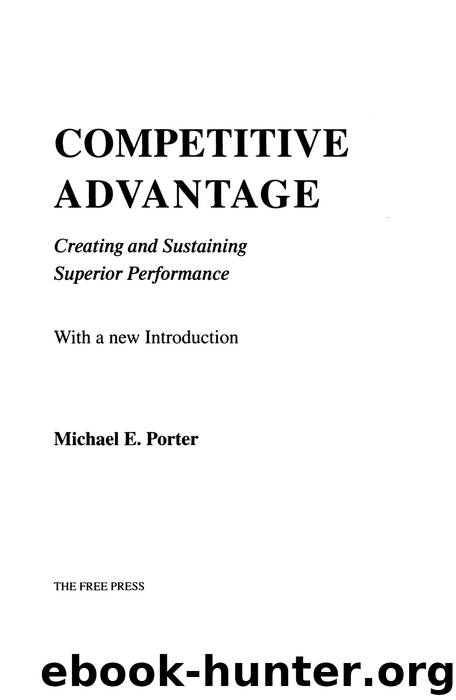Competitive Advantage by Michael E. Porter

Author:Michael E. Porter
Language: eng
Format: epub
Publisher: Free Press
Switching Costs
Substitution always involves some costs of switching to the substitute for the buyer, which are weighed against RVP. The higher the switching cost relatively, the more difficult substitution will be. Switching costs in substitution are analogous to those of changing from one supplier to another in an industry.4 Switching costs are usually higher in substitution than in switching suppliers, however, because substitution may require switching to a new supplier plus switching to a new way of performing a function.
Switching costs potentially arise from all the impacts a substitute has on the buyer’s value chain. Both the value activity in which the substitute is employed as well as other value activities it indirectly affects may require one-time costs of changeover. Switching costs most common in substitution are the following:
Identifying and Qualifying Sources. Finding sources for the substitute and gathering information about them are switching costs. So is the need to test a substitute to see if it meets performance standards. The cost of qualifying a 64K memory chip to replace a 16K chip has been estimated at $50,000, for example, and the process can take as long as a year.
Cost of Redesign or Reformulation. A buyer’s product or value activities must often be redesigned to accept a substitute. Reformulating a consumer food product to accept high-fructose corn syrup instead of sugar, for example, requires out-of-pocket costs as well as the time and opportunity cost involved in testing the reformulated product. Redesign costs can affect many value activities. The layout of an entire plant must be changed to get the benefits of a new materials handling system, for example. Similarly, purchasing synthetically produced gas made from coal gasification instead of natural gas requires a user to modify gas burning equipment because of synthetic gas’s slightly different qualities. The cost of redesign or reformulation will be lower if the buyer is changing product generations or building a new facility anyway.
Retraining or Relearning Costs. Switching to a substitute often requires learning how to use the substitute or changing use patterns. A typist who has been using a manual typewriter must get used to the much lighter touch of an electric one, for example, while a cook must learn a new set of cooking procedures to use a microwave. Similarly, plant engineers and maintenance personnel must go down the learning curve with a new type of machine tool.
The cost of retraining includes the cost of downtime and higher reject rates during the shakedown period and other such costs besides the out-of-pocket costs of learning or training themselves. Retraining costs will be highest where a substitute is used very differently from the product. Shifting from black and white to color TV is easy, for example, while shifting from conventional ovens to microwave ovens requires learning about oven operation, procedures, cooking times, and how to get the best results with different foods.
Changing Role of the User. Quite apart from the need to learn new behavior, substitution frequently involves a change in role for the user that can be a positive or negative influence on the cost of switching.
Download
This site does not store any files on its server. We only index and link to content provided by other sites. Please contact the content providers to delete copyright contents if any and email us, we'll remove relevant links or contents immediately.
International Integration of the Brazilian Economy by Elias C. Grivoyannis(57323)
The Radium Girls by Kate Moore(10907)
Turbulence by E. J. Noyes(7039)
Nudge - Improving Decisions about Health, Wealth, and Happiness by Thaler Sunstein(6633)
The Black Swan by Nassim Nicholas Taleb(6190)
Pioneering Portfolio Management by David F. Swensen(5606)
Rich Dad Poor Dad by Robert T. Kiyosaki(5149)
Zero to One by Peter Thiel(4824)
Man-made Catastrophes and Risk Information Concealment by Dmitry Chernov & Didier Sornette(4736)
Secrecy World by Jake Bernstein(3782)
Millionaire: The Philanderer, Gambler, and Duelist Who Invented Modern Finance by Janet Gleeson(3569)
Skin in the Game by Nassim Nicholas Taleb(3460)
The Age of Surveillance Capitalism by Shoshana Zuboff(3422)
The Money Culture by Michael Lewis(3284)
Skin in the Game: Hidden Asymmetries in Daily Life by Nassim Nicholas Taleb(3264)
Bullshit Jobs by David Graeber(3179)
The Dhandho Investor by Mohnish Pabrai(3168)
The Wisdom of Finance by Mihir Desai(3078)
Blockchain Basics by Daniel Drescher(2891)
